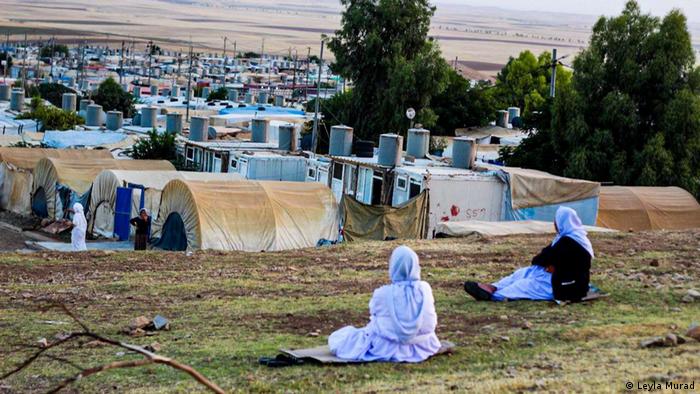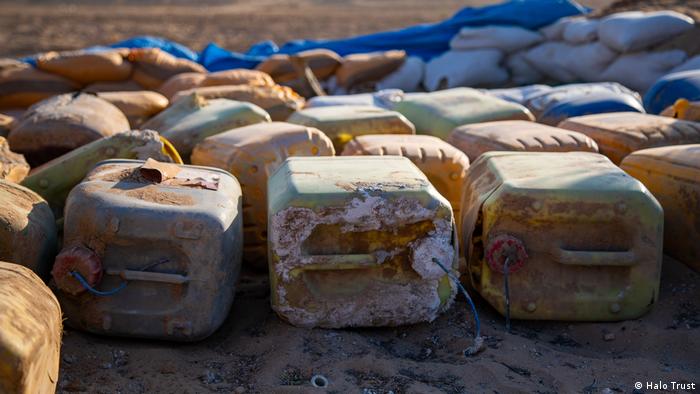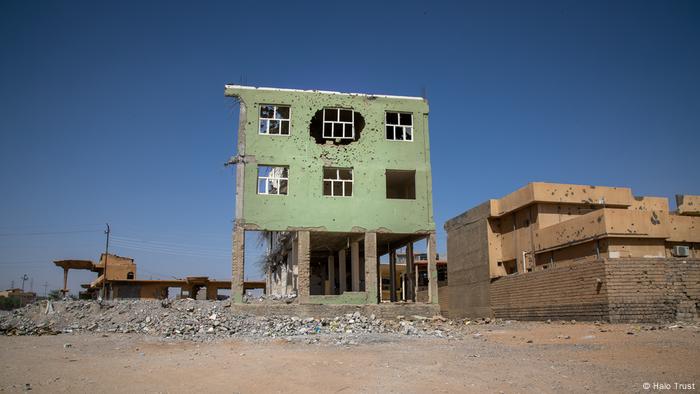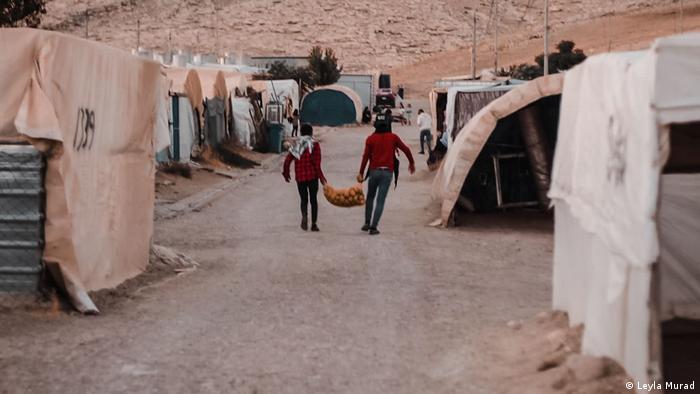With several million pieces of mines and explosives lying under the rubble and soil across Iraq, many internally displaced people prefer living in camps to returning home.

Iraq remains among the countries most contaminated by landmines and explosive remnants of war, despite decades of clearance efforts
"It happened to one of my uncles two years ago. As a shepherd, he used to take his flock out in the field. One day, he stepped on a landmine that was hidden under the soil. As a result, he was left severely disabled."
This is only one of the stories that Leyla Murad, a 22-year-old Iraqi woman, can recount about landmines destroying people's lives. "I have a dozen of them; stories of adults, children and animals shredded into pieces by mines," she told DW.
Originally from Sinjar, a region in northwest Iraq, Murad and her family have been living in the Essian camp for internally displaced people In Ninewa province for eight years. In August 2014, as the "Islamic State" (IS) was rapidly advancing in Sinjar, they left everything behind and ran for their lives.
Layla shares three smallish cabin rooms with her parents, three adult siblings and their grandmother. This has been their home for the last eight years. "It looks nothing like our village house, which we left behind," she said.

Leyla Murad's photo from Essian camp for internally displaced people, where she lives with her family
Even though the war ended five years ago, moving back to their village is not an option for the Murad family, as is also the case for thousands of other Iraqis living in such camps.
"There is nothing left there but ruins, full of explosives," Murad said. "My uncle returned home, but it was a big mistake."
The most mine-polluted country in the world
Scattered across almost every corner of Iraq are millions of landmines, buried in the farms, roads and fields.
The International Campaign to Ban Landmines classifies Iraq as the world's most contaminated country with mines.
Every year, dozens of Iraqis lose their lives due to explosion of mines and military debris; while about 8.5 million out of 41 million Iraqis live under this threat, UN Mine Action Service data shows.
Various conflicts have devastated the nation since the early 1980s, each adding to the extent and density of its mine pollution. The 1980s Iran-Iraq War, Saddam Hussein's war against the Iraqi Kurds, the 1991 Gulf War, and the 2003 US-led invasion left behind vast minefields and unexploded cluster munitions.

IS planted numerous improvised explosive devices or handmade mines, such as these pictured, in areas it once controlled
Most recent was IS's pervasive, industrial-scale use of improvised explosive devices (IEDs), and many inactivated mortar and artillery ammunition remain amid the rubble from clashes between the insurgent group and Iraqi government forces.
A long way to go
Iraqis have been removing mines from their land for decades, but there has been a lack of clearance work in places where IS formerly had taken control, Paul MacCann, the communications manager of Halo Trust, a philanthropic organization that clears mines and explosive debris, told DW.
"The type of mines IS built tend to be a 20-liter (5.2 gallons) plastic cooking oil container filled with homemade explosives, a detonator, a battery and a switch," MacCann pointed out. "The switch is something that people could stand on or drive over that will initiate the explosion."
Recently, in a single minefield next to an oil refinery around the town of Baiji in northern Iraq, the organization removed about 700 IEDs, while another hundred pieces were collected in other parts of the town.
"In addition to the IEDs, we're also helping to clear buildings which may have been bombed in the fighting," MacCann said. "These buildings usually contain unexploded cluster munitions, shells that didn't go off during the war. They are covered by piles of concrete and rubble and need to be handled very carefully."
Due to the large scale of contamination, the organizations has had to "industrialize the process of clearing, using armored vehicles," MacCann noted.

Bombarded buildings like this one might house unexploded shells
But it takes months for a single minefield to be cleaned and years before Iraq's many minefields disappear. In December, Iraq's environment minister, Jassem Al-Falahi, was quoted by the state news agency INA as saying the nation will get rid of the minefields created during the war against IS by the end of 2028.
For Iraq's remaining 1.2 million IDPs, that means that camps are safer places to live for years to come.
War has ended, but peace has not been achieved
"Landmine contamination is not the only reason why Iraqis are reluctant to return home," Mustafa Laith Qassim, a journalist and aid worker with the Rafidain Youth Movement, an Iraqi charity for IDPs, told DW.
"For example, occasionally clashes break out between the militias that used to fight IS, both in Kurdish areas and the rest of Iraq, putting civilian lives in danger," he said. "Sometimes people feel they have nothing to return to, after seeing houses, schools and hospitals leveled to the ground."

mine pollution hampers reconstruction efforts, discouraging thousands of internally displaced families who hope to return home
"But the mine problem is particularly disheartening," he continued. "Because in addition to being serious safety risks, mines and explosives hinder the reconstruction and development of the contaminated areas."
Over a quarter of explosive ordnance contamination is located in Iraq's agricultural areas, preventing farmers from using their lands to feed their families, according to a UNMAS report. Another 20% affects infrastructure, interrupting reconstruction efforts to reopen businesses. An additional 20% have been planted along the roads, potentially isolating the nearby towns and villages from the rest of the country.
"When there are landmines and unexploded weapons, people don't believe that peace has fully been achieved," said MacCann. "It feels like the war is still continuing."
That is exactly how Leyla Murad feels.
"We have witnessed too many people getting killed in Sinjar in peacetime," she said. "Too many want to take the risk of returning home."
Leyla spends her days pursuing photography, making DIY crafts, and learning new skills. She has joined an NGO called Lotus flower, which focuses on the well-being of the camp's women and girls. "I have my whole life here now."
"My family and I would have loved to go back to our home one day, knowing we would be safe," she said." but honestly I don't see that coming."
Edited by: Rob Mudge
No comments:
Post a Comment